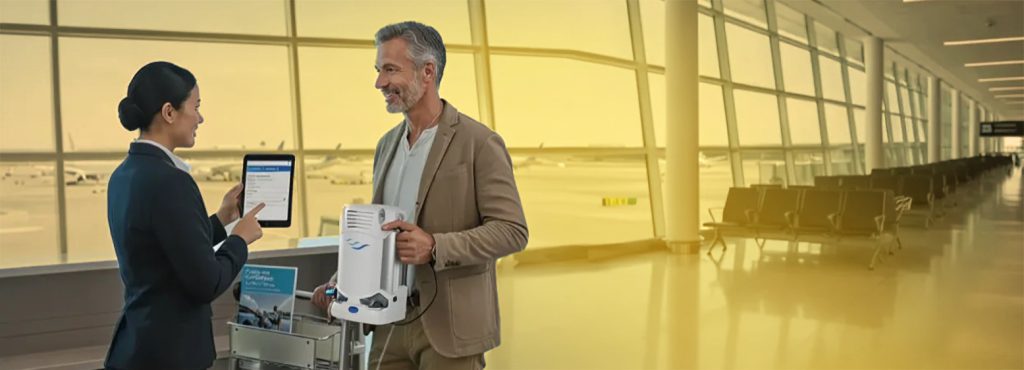Do you find yourself stressed out or anxious whenever you think of flying with oxygen concentrators just because you rely on medical oxygen for air travel?
Well, travelling by air or going on a cruise while managing a medical condition can sure feel daunting, but with the right preparation, it’s not just safe and feasible but also very comfortable. Whether you’re flying or taking a cruise, you just need to follow the specific guidelines for using travel oxygen machines, and you’ll be good to go!
In this article, we will explain everything you need to know about flying with oxygen concentrators and using medical oxygen in cruise cabin.

Important guidelines
If you plan on flying with oxygen concentrators, it’s important to follow the travel and medical device regulations of your airline and country.
In the United States, for example, the Federal Aviation Administration (FAA) sets the rules for using portable oxygen concentrators during flights.
Only FAA-approved oxygen concentrators are allowed on U.S. commercial aircraft.
Most well-known brands, such as Inogen, Philips Respironics, and AirSep, manufacture devices that comply with FAA standards. You can read about the basic features of each of these models here.
To qualify for FAA acceptance, a POC must:
- Be legally marketed and cleared by the U.S. Food and Drug Administration (FDA)
- Display a label stating that it meets FAA requirements for in-flight use
- Operate safely without producing compressed oxygen or creating fire risks
Similarly, in Europe, airlines follow standards from the European Union Aviation Safety Agency (EASA).
Steps to Prepare for Air Travel with Oxygen
1. Consult your doctor
First and foremost, you need to consult your healthcare provider and request that they issue a medical certificate or “fit-to-fly” letter. This states your need for oxygen, flow rate, and that you can operate the device safely. Although many airlines don’t require this, some do, so you need to check and make arrangements accordingly.
2. Notify the airline early
Contact your airline at least 48–72 hours before your flight. Let them know that you’ll be flying with an oxygen concentrator, and provide the model name and approval label details.
3. Carry enough batteries
Many airlines require enough battery life for at least 150% of the total flight time to account for delays. So, don’t forget to carry your extra batteries in a carry-on bag.
4. Don’t expect airline-supplied oxygen
Most airlines no longer provide onboard oxygen for passengers, so you need to bring your own medical oxygen for air travel.
With all this, you’ll be ready to board comfortably and confidently, knowing your health needs are covered and you’re following all rules, and if you’re looking for some extra and personalised support, you can see our step-by-step service procedure here, which is focused on maximizing your comfort.
Similarly, if you’re planning to use Medical Oxygen in the Cruise Cabin, you’ll be happy to know that oxygen cruise liners readily accommodate passengers who need oxygen therapy.
Many of them allow oxygen tanks, portable oxygen concentrators, and also permit renting machines.
However, just as with air carriers, cruise lines have their own rules about carrying oxygen in the cruise cabin, so you’ll need to do your research and make arrangements in advance.
FAQs
Q: Can I bring any oxygen machine?
Not always. For flying with oxygen concentrators (air travel), you must use a POC that meets the acceptance criteria or is listed/approved by the airline. For a cruise, you must follow the cruise line’s policy, which may permit POCs or cylinders with advance notice.
Q: If my oxygen device is approved by aviation safety authorities, does that mean the airline will automatically allow it?
Not always. Approval from aviation regulators like the FAA in the United States or other national aviation authorities worldwide only means the device meets important safety standards. It sure does help, but it does not guarantee that every airline will accept it. This is because each airline has its own medical and equipment rules, and many still require things like an advance notification, a doctor’s letter, and a certain number of backup batteries. So you must always check your airline’s specific policy before flying.
Q: Can I rent a POC instead of buying?
Yes. Many travel suppliers allow you to rent a POC for your trip. This can reduce cost and improve portability.
Q: What about using oxygen tanks?
For air travel, oxygen tanks are far more restricted and often not permitted unless the airline specifically allows and you coordinate it. For cruises, some lines allow tanks, but with more conditions, so you should always verify beforehand. Either way, most people agree that portable oxygen concentrators are far easier to travel with, so choose wisely.
Conclusion
By learning the rules for flying with oxygen concentrators, you can explore the world safely, confidently, and comfortably. Your travel oxygen machine is here to give you independence, not to limit you.
And if you ever feel confused about choosing the most appropriate device that will accompany you on your adventures, feel free to reach out to us and receive personalized product recommendations before buying, because as a trusted UK-based provider of portable oxygen concentrators, we at Travelling with Oxygen are here to help you travel with confidence while fulfilling all your oxygen needs!
If you’re looking for more details on how to make your journey easier and more comfortable, make sure to read our full guide on traveling freely with a portable travel oxygen concentrator.
Have any questions or queries? Feel free to hit us up.

